YOU ARE WHAT YOU IS: ROCK 'N ROLL AND OTHER STYLES
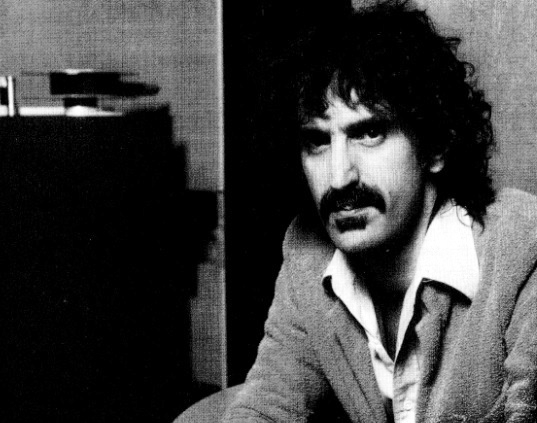 "You are what you is" (fall 1981) is a continuation upon the commercial success of "Sheik Yerbouti" and "Joe's garage, act I".
Much of the album has to do with familiar chord progressions and stylistic conventions. All is done
with productional craftsmanship regarding sound quality and vocal harmonies. It's pleasant listening to this music and
especially the various extras that go beyond conventions indicate that there's someone with a high musical
capacity behind this album.
"You are what you is" (fall 1981) is a continuation upon the commercial success of "Sheik Yerbouti" and "Joe's garage, act I".
Much of the album has to do with familiar chord progressions and stylistic conventions. All is done
with productional craftsmanship regarding sound quality and vocal harmonies. It's pleasant listening to this music and
especially the various extras that go beyond conventions indicate that there's someone with a high musical
capacity behind this album.
Rock journalists seldom use note examples to clarify what the music they are writing about goes like. Rather they prefer
to classify music by categorizing it into a wide range of styles and to tell who got influenced by whom. To call an artist "influential"
has become the biggest cliche remark in rock writing. Many of these styles aren't styles in an abstract technical sense, but more like groupings of similar
sounding albums from a certain period. Some songs get mentioned as exemplary of a style. California pop means little more than sounding as
Fleetwood Mac and grunge means little more than sounding as Nirvana. Zappa changed the sound of his music about every album and on each
one new stylistic directions can be found. The transitions can be flabbergasting, like from "Lumpy gravy" to "Cruising with Ruben and the Jets"
or from "Just another band from L.A." to "Waka/Jawaka". From the technical perspective, reviews about Zappa are often kind of weird
as it comes to attempts to say something about his music, but it doesn't really matter. As the saying goes, as long as it gets reviewed it's ok,
preferably positive.
Zappa never aimed at one characteristic sound or a certain style. Instead of that, he kept doing whatever came up to him for all of his career,
only kept together by what he himself called a "conceptual continuity". It's more an attitude towards music than a specific direction. How much
has "Dance me this" drifted away from "Freak out!". This section mentions a couple of common styles you can encounter in Zappa's music, styles that
have characteristics regarding their black dots (thus not only the sound). It's certainly
not meant as complete, I'm just letting some passing by. To the right: part of a FZ photo by John Livzey as reproduced in the FZ Guitar book,
page 204.
1. Teen-age wind (studio version)
Like "Apostrophe (')", "You are what you is" begins
with the sound of blowing winds, this time figuratively referring to the
lyrics of the opening song. In the Neil Slaven biography, page 238,
you can read how Zappa wrote "Teen-age wind" as a reaction upon Arthur Barrow
playing the Christopher Cross hit "Ride like the wind" to him.
Teen-age wind, 0:03-0:31 (midi file).
Teen-age wind, 0:03-0:31 (transcription).
The lead melody from theme one from "Teen-age wind" is present in the Ludwig study, pages 274-5. In 2025 I transcribed the opening from the
"You are what you is" version, as well as the "Halloween 81" live performance, leading to a renewed description (the one untill then
was done too hastely, containing inaccuracies):
- 0:00 Rushing wind.
- 0:03 Intro. Rhythmically this is reggae. Ludwig notated this song in G# minor. The opening is ambiguous about its key, however, especially
when you compare it with the "Halloween 81" version, where this song starts in G Mixolydian.
During this intro the accent lies on the F# chord and an E/E# isn't present.
- 0:14 Theme one in 4/4, twice interrupted by a bar with a different meter. In bars 5-6 the E/E# turns up in the harmonies as E#,
so the song can be better be identified as G# Dorian at this point. In bars 6-7 the B switches from B to B#.
- 0:29 Theme one over a B pedal, the key thus switching to B Lydian by a transposition of the pedal note. This is happening in bar 11 in the
example from above. As you can see the melody remains largely the same.
- 0:42 Repetition from the intro onwards.
- 1:22 Theme two.
- 1:45 Theme three.
- 1:57 Theme four/chorus in a couple of set-ups.
- 3:01 End.
Continued in the next section with "Teen-age wind (live)".
Country
2. Harder than your husband
Former Mothers of Invention drummer Jimmy Carl Black made a guest appearance in a traditional country song "Harder than you husband"
with hypocrite standard break-up lyrics ("it's better for you"). More complex country-based Zappa songs are for instance "Truck driver divorce" on "Them or us" (1984),
and, regarding thematic variety, "Rhymin' man" on "Broadway the hard way" (1988). Sections of the last two songs are included in the corresponding sections of this study.
Earlier examples are "Lonesome cowboy Burt" from "200 Motels" and "Poofters froth Wyoming plans ahead" from "Bongo fury". See the 200 Motels
section for the opening bars from "Lonesome cowboy Burt".
Harder than your husband, refrain (midi file).
Harder than your husband, end (midi file).
Harder than your husband, refrain (transcription).
Harder than your husband, end (transcription).
The first example above is the refrain from this song. Bars 1-4 form a conventional harmonic pattern, I-IV-V-IV-V-I in C. With bars 5-8 Zappa evades
to other scales. This second half of the refrain starts in Bb and gradually moves back to step V of C. This is done by first letting the Eb become natural
again on beat 4 of bar 6 and finally the Bb also gets natural again in bar 8. Regarding scales the situation remains ambiguous however, because these two notes, that make
the difference, are half of the time absent. Bars 5-8 can maybe better be interpreted as a chord progression unrelated to scales: Bb-F-Bb-F-Dm-F-C-G. The second
example contains the end of this song. Zappa mostly lets his songs end in one of the following manners:
- End with one or more closing chords, in case of tonal music normally a harmonic cadence. This is the standard for classical music and pop bands playing life.
- End with, mostly, the main theme repeating and fading out. This has become the standard for pop songs recorded in the studio.
- End overnight at the end of a bar or a certain point in a bar and let the next song segue without any pause.
- End overnight at an arbitrary point and let the next song segue without any pause.
The last two ways are uncommon, because they make a change sound rather abrupt (actually I only know of Zappa doing this, but that doesn't mean much).
Though stylistically different, "Harder than you husband", "Doreen" and "Goblin girl" are musically interwoven in subtle manners. The classical ending
of "Harder than you husband" would have been bar 2 from the second example. Here the songs comes at rest with the I chord from C, confirming the tonic.
It gets followed, however, by two variations upon bar 5 from the previous example, that get repeated a few times. These two bars thus become the coda.
What would be the final chord, or even the scale, remains undecided within "Harder than you husband". The E/Eb is absent during these variations, and two
chords are dealt with as equal: Bb-F (I've notated it with Bb and Eb in the presets, because it's a variation upon the earlier bar 5 from the first example, where
the Eb does occur). Zappa lets "Harder than you husband" end with a 3/8 bar and "Doreen" segues with the F chord. So, in a way
of speaking, "Doreen" decides that F is the closing chord for "Harder than you husband". Harmonically the transition is thus taking place smoothly. Regarding style,
"Doreen" is pretty different and there's also a tempo change.
Rock and roll
3. Doreen (1981) - Tengo na minchia tanta
The opening of "Doreen" is pure conventionalism, for its lyrics and for its chord progressions.
It starts with I-IV-V in F. As a guitar-chord-riff they give the song a rock character. Bars 1-4 contain this progression twice.
When the lyrics begin the sequence of the chords changes to V-IV-I-IV-V.
Doreen (1981), 0:00-0:29 (midi file).
Doreen (1981), 0:00-0:29 (transcription).
Globally "Doreen" knows an intro, two themes and a guitar solo:
- 0:00 Instrumental intro.
- 0:09 First theme.
- 0:44 Second theme.
- 1:05 First theme.
- 1:36 A vamp is formed.
- 1:55 A guitar solo over this vamp begins.
- 4:43 End.
Doreen (1981), 4:27-4:43 (midi file).
Doreen (1981), 4:27-4:43 (transcription).
When the vamp begins the song has modulated to F Dorian with the bass playing the line F-Ab-Bb. A chorus is singing "to-night" around E-D, while
others singers are improvising more freely. The second example from above contains the end of the song. Bars 1-4 contain the last two episodes
with the vamp and the guitar solo, bars 5-8 serve as an outro. The final bar contains a sung F7 chord, a little evading from F Dorian. It last 3/8
because Zappa liked to move over to the next song in a sudden way.
It's transcribed by approximation only. With many participants it's difficult to hear the details, in particular
the keyboard chords are hard to discern. For Zappa standards this is quite an unusual vamp: it's dense, it includes vocals and regarding volume it's louder than the guitar solo.
The vamp for the solo from "Dumb all over" (track 15) also includes vocals, to my knowledge these are the only two examples of guitar solo vamps with a vocal line.
The opening of a live version of "Doreen (1982)" is included in the "You can't do that on stage anymore, vol. V" section.
"Stevie's spanking" from the "Dub room special"/"Them or us" is another example of regular rock 'n roll in 4/4.
Up till the 5th edition of this study this song was included in this section for that reason, but in 2025 I transcribed some for more examples from
the "Dub room special" and "Halloween 81", giving these two CDs a section of their own.
See below at "Beauty knows no pain" for an unconventional example of rock 'n roll. Or at "I come from nowhere" from the
Drowning witch section of this study.
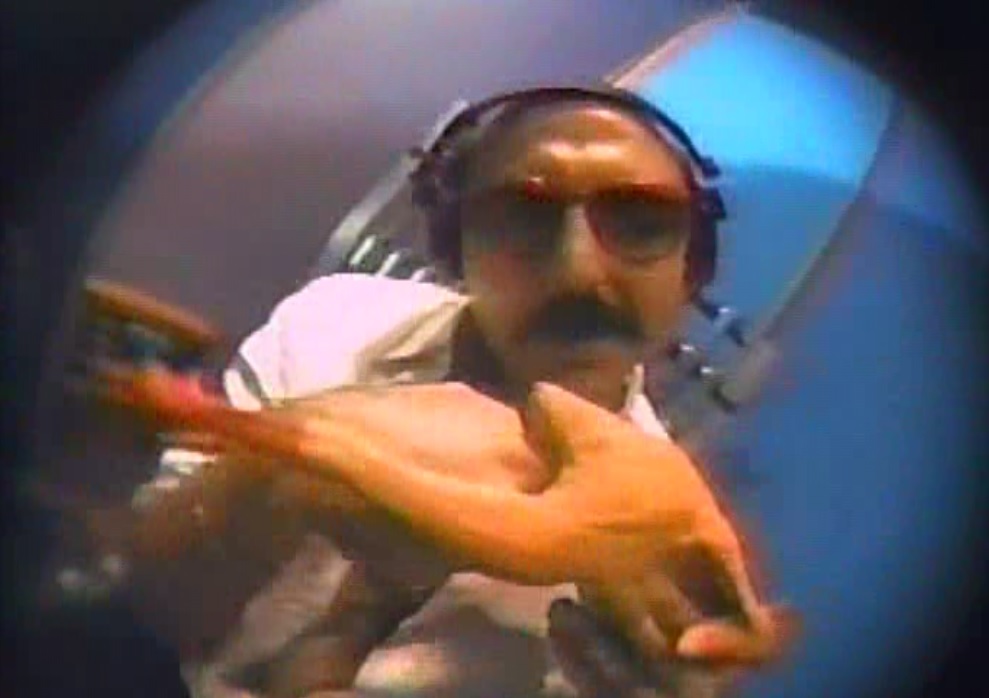 "Tengo na minchia tanta" features the Italian reporter Massimo Bassoli. It was recorded around 1982 for the final third
round of the "Uncle meat" movie and included in the CD version of the corresponding album. As an example of rock 'n roll
I've included this song in this section.
The lyrics of this song are in Italian. One can look up a translation
on the net, but the fun part of it is that both Zappa and Bassoli knew that the majority of listeners can't understand the lyrics. Its
subdued sexual implications are meant to be tantamount to truly understanding it, underscored by some passages in English as "come on baby, suck
my fire". Apparently it's not about the correct original way of preparing Spagetti Napolitana, but the need for a chicken to measure a large dick.
"Tengo na minchia tanta" features the Italian reporter Massimo Bassoli. It was recorded around 1982 for the final third
round of the "Uncle meat" movie and included in the CD version of the corresponding album. As an example of rock 'n roll
I've included this song in this section.
The lyrics of this song are in Italian. One can look up a translation
on the net, but the fun part of it is that both Zappa and Bassoli knew that the majority of listeners can't understand the lyrics. Its
subdued sexual implications are meant to be tantamount to truly understanding it, underscored by some passages in English as "come on baby, suck
my fire". Apparently it's not about the correct original way of preparing Spagetti Napolitana, but the need for a chicken to measure a large dick.
Tengo na minchia tanta, theme (midi file).
Tengo na minchia tanta, theme (transcription).
Musically it's straightforward rock 'n roll in G minor with 4/4 as meter. The song knows two themes, that keep alternating each other. Both are included
in the example above. Bars 1-4 are theme one, with a motif played in two slightly different shapes. The same goes for theme two (bars 5-8). While theme
one is on beat, theme two comprehends a syncopic figure with 3-4-4-5 as subdivision. Bassoli is singing over it flatly, somewhere between normal singing and speech-wise singing,
hitting upon altered notes and creating dissonances.
Above: Massimo Bassoli singing "Tengo na minchia tanta". Source: Uncle Meat movie.
4. Goblin girl
One of the extras on "You are what you is" is for instance how the melody of "Doreen" returns more slowly
during the second half of "Goblin girl". It's sung over one of the "Goblin girl" themes vamping while a
third voice joins in with horny fantasies about the girls in the green Goblin suits. This polyphonic
writing style is quite rare in pop music.
Goblin girl, 1:58-2:22 (midi file).
Goblin girl, 1:58-2:22 (transcription).
From bar 4 onwards in the example above you've got:
- Staff 1: comments in the shape of a meltdown.
- Staff 2: chorus singing the "Doreen" melody.
- Staff 3: vocal singing "Take a green girl".
- Staves 4-5: chorus singing "The Goblin girl from the mystery world".
- Staff 6: keyboard harmonies.
- Staff 7: bass figure.
The bass sets the key to F# Dorian (sort of, Zappa changed the speed in a way that it gets between keyboard frequencies). Except from staff 6, the figures form a five part counterpoint structure, with three of them vamping.
The choruses and keyboard are all using chords. Individually they are using chord progressions, but their overall combinations, bass included, are mingling
the notes of the whole F# Dorian scale.
5. Theme from the 3rd. movement of Sinister Footwear
An example from the "Theme from the 3rd. movement of Sinister Footwear" is dealt with in the Them or us section
of this study. The whole solo is transcribed by Steve Vai in the Frank Zappa guitar book, pages 206-212. It's the only independent guitar solo from
"You are what you is". The other larger ones are directly related to the songs they are part of for using a figure from the song as a vamp:
- Doreen solo: played over a vamping figure with lyrics. For some reason Zappa decided to mix the solo to the background.
- Dumb all over solo: again played over a vamping figure with lyrics. Now the solo is equal in volume compared to the vamp, forming a duet with it.
- Conehead and If only she woulda solo: solo over an instrumental figure vamping. This time the vamp is playing in the background,
being closer to Zappa's regular way of soloing during a song.
Overall, and compared to the other albums surrounding it, solos are less important on "You are what you is". In the first place it's a vocal album.

Bars 4-5 from the "Theme from the 3rd. movement of Sinister Footwear" as transcribed by Steve Vai with the beginning of the guitar solo.
This transcription includes the original drum part by Vinnie Colaiuta as recorded live ("Persona non grata" version).
See the Them or us section for more.
The solo would return in a different shape on the later "Guitar" collection as "Variations on Sinister #3".
The opening of that version is included in the corresponding section, where you can see bar 5 from above being varied upon.
6. Society pages
With these tracks a series begins about people from the society world, their obsession with beauty and abuse of drugs.
"Society pages" could be called a rock song, specifically the second theme. It begins with an instrumental riff of four bars in 4/8, that is in the way
I've notated it. It accompanies the main theme, being played really fast compared to the lyrics. It's in Bb Mixolydian,
mingling the Bb and Ab chords.
Society pages, opening (midi file).
Society pages, opening (transcription).
The whole song is using four themes, stylistically quite different from each other, so the above is only one of its aspects.
The themes are played as follows:
0:00 Main theme ("you're the ol' lady ...").
0:30 Second theme ("oh lady, oh lady ...").
0:42 Third theme ("the hospital plans ...").
0:58 Main theme ("somehow, ...").
1:50 Fourth theme ("some day ...").
2:01 Second theme.
2:11 Third theme ("by the grace ...").
7. I'm a beautiful guy
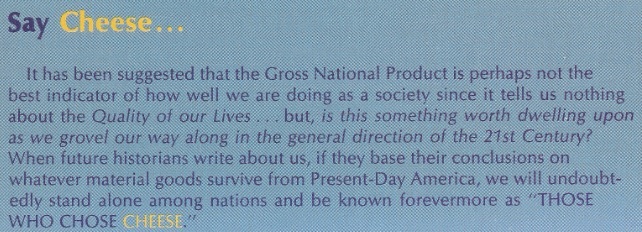 "I'm a beautiful guy" is a short collage-like song with a sequence of themes.
Tracks 6-11 all directly segue, as are the lyrics flowing from one song into the next. It's written as a little story
with episodes. Two more sequences of textually related songs can be found on "You are what you is" (see below).
All three are outspoken examples of Zappa's social criticism, as is the addendum to the CD booklet (formerly
the album inner cover). It's an article, called "Say cheese ...", that got rejected by Newsweek for being too idiosyncratic.
Above to the right its first paragraph in the lay-out from the original album. The text is also included in the CD booklet.
"I'm a beautiful guy" is a short collage-like song with a sequence of themes.
Tracks 6-11 all directly segue, as are the lyrics flowing from one song into the next. It's written as a little story
with episodes. Two more sequences of textually related songs can be found on "You are what you is" (see below).
All three are outspoken examples of Zappa's social criticism, as is the addendum to the CD booklet (formerly
the album inner cover). It's an article, called "Say cheese ...", that got rejected by Newsweek for being too idiosyncratic.
Above to the right its first paragraph in the lay-out from the original album. The text is also included in the CD booklet.
On page 108 of his study, W. Ludwig is pointing at the use of odd meters during tracks 7-9, probably being the reason why
Zappa called this sequence hard to play on "YCDTOSA vol. III": "the "You are what you is" album has layer upon layer
of over-dubs and many bizarre edits. The nightly challenge for the 1981 band was to replicate it - edits and all - on a
live concert stage".
Roughly, "I'm a beautiful guy", can be subdivided into the following sections:
- 0:00-0:12 Instrumental intro.
As it comes to complexity, Ludwig is for instance saying: "the introductory riff, played twice, is subdivided as
an 11/8 bar (5/8 and 6/8) and a 9/8 bar (5/8 and 4/8)". Ludwig's comments are continued below at "Charlie's enormous mouth".
I'm a beautiful guy, 0:00-0:16 (midi file).
I'm a beautiful guy, 0:00-0:16 (transcription).
The example above is the intro plus the first phrase from the first theme block.
The meters of the riff are as indicated by Ludwig. Notational variants are possible; during the 6/8 bar you can hear three drumbeats, so I've notated this as 3/4. At first it's just guitar and drums with some harmony
fill-in in the background. It's in the uncommon key of G Locrian.
The riff gets interrupted by a pattern-breaking figure with five septuplets (bars 9-13), something Zappa liked to do.
See the "Inca roads" and "Dinah-Moe Humm" examples from this study for other instances. It's an atonal sequence, having nothing in commom with the riff.
The first sung theme can be seen as a form of polyrhythms. The singer takes a dotted eight note as time unit, while the bass is using a quarter not as unit.
Because of this, the bass and sung melody are unequal most of the time. Only in bar 19 their downbeats coincide.
- 0:12-0:34 First theme block, "I'm a beautiful guy ..."
- 0:34-1:00 Second theme block, "So I want to know why ..."
- 1:00-1:14 Third theme block, "They're are drinking lighter ..."
- 1:14-1:39 Fourth theme block, "Hey. Your athletic appoach ..."
- 1:39-1:56 Transition to the next track, "Her beauty, of course, can feel no pain".
8. Beauty knows no pain
"Beauty knows no pain" is complex rock 'n roll, using changing metres and scales. The odd 18/16 metre is a difficult figure,
subdivided as 5+5+2+2+2+2. You can learn it by counting through it as one-two-three-four-five one-two-three-four-five
one-two one-two one-two one-two and then speed up the pace. Or listen to how it sounds on record, get it in your recollection and
reproduce it. The song starts in G Dorian. Bar 1 has the bass note going from Bb to G to C, leaving it in the middle what
the key note might be. Only in bar 4, when the progression comes at a rest on G, a choice is made for G.
Bar 8 is chromatic, containing a series of parallel minor thirds.
Beauty knows no pain, opening (midi file).
Beauty knows no pain, opening (transcription).
The 1981 Halloween concert was broadcast by MTV with the title "You are what you is" and sections are included in Zappa's
"Dub room special" DVD as well. The ZFT made 10 of the 15 tracks from the "Dub room special" available on CD,
with two tracks from the MTV show, whereas various other tracks from this concert - not on the DVD/CD - are
included in the YCDTOSA series. Eventually a 5-CD set with material from these concerts was released as "Halloween 81",
a reason to create a new seperate section in this study about this material in the spring update of 2025.
A friend of mine was advertising Zappa in that period and at the age of 19 I watched the MTV
concert. It made me decide to buy a Zappa record, "Drowning witch" it became. It was not the music, but Zappa's stage
behaviour that made me try it out. Here was someone not shouting and dancing all the time, but sincerely performing music. His
music never appealed to me at once and it took me more than a year to understand most of "Drowning witch". At first I thought the solos
were album fillers, but at the time I got to buying "Shut up 'n play yer guitar", I was forced to listen more carefully. Well, as long as you can learn
from your mistakes.
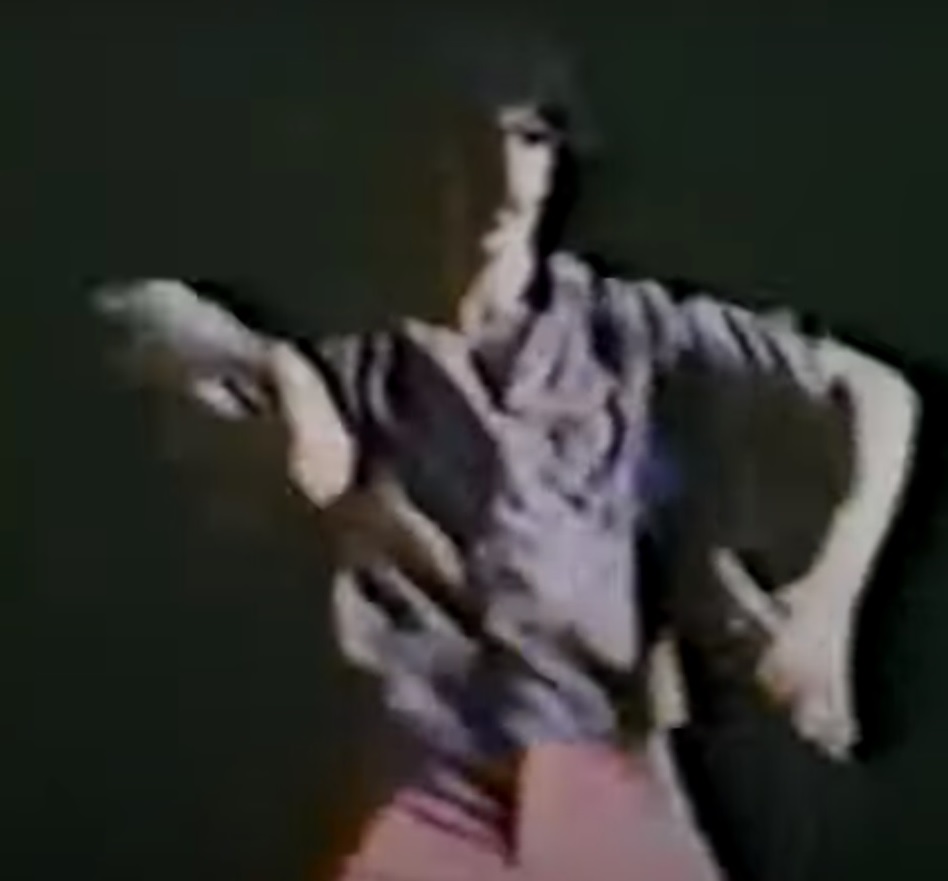
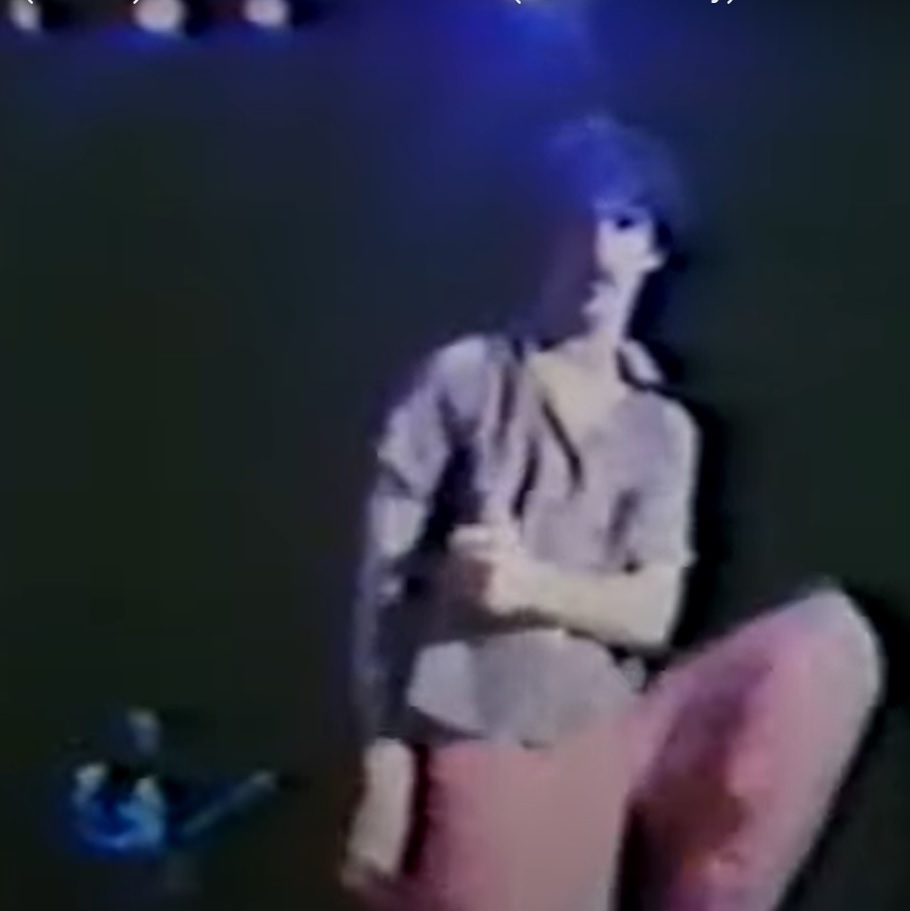
A rare instance of Zappa doing dance steps, here during a 1980 performance of "Beauty knows no pain".
Two stills from the Frank Zappa: New York and Elsewhere documentary by Rudi Dolezal and Hannes Rossacher.
9. Charlie's enormous mouth
"Beauty knows no pain" segues into "Charlie's enormous mouth". This last song is very accessible mainstream music. That doesn't apply to the lyrics, that are kind of brutally formulated.
It also doesn't go for the meters, of which Ludwig is saying: "The piano introduction, being blended with the end of "Beauty knows no pain",
knows a 10/4 meter (4/4 plus 4/4 plus 2/4). After being played three times, a short break of two times 4/4 can be heard. The next 9/4
bar (5/4 plus 4/4) for the words "Charlie's enormous mouth" is yet another example of odd additive meters as a result of what's
probably speech-influenced".
Charlie's enormous mouth, 0:59-1:25 (midi file).
Charlie's enormous mouth, 0:59-1:25 (transcription).
"Charlie's enormous mouth" is in Ab, sometimes touching upon Ab Mixolydian too. The song is indeed characterized by varying meters. The example above is taken from the middle of this song. It contains:
- Bars 1-3: "They call it the mouth": standard 4/4.
- Bar 4: first bar with "la-la-la": 5/4, the reason for extending the previous 4/4 bar is musical.
- Bar 5: first bar with "la-la-la": 6/4, again an extra beat adds an additional pause for musical reasons.
- Bar 6: "Kinda young kinda wow": 7/4. At various points in this song bars gets extended for the guitars to add little improvised intermezzi.
- Bar 7: "Charlie's enormous nose": 9/8. This time the odd meter is speech-influenced, as correctly described by Ludwig (9/4, taking a different time unit).
This bar sounds natural because of this speech-influence, but when you try to dance to this song or nod your heath to it, it causes a brief hick-up.
- Bar 8: "But it's all white": 6/4. Like bar 6, the extension is used for instrumental soloing. "White" is in the context of this song obviously a reference to the use of cocaine.
- Bar 9: "The girl got a very large nose": 6/4, speech-influenced, but not leading to a change of meters.
- Bar 10: "But it's all white": 6/4. As bar 8, with the bass taking part of the soloing too this time.
10. Any downers (1981)
An interesting earlier version of "Any downers (1975)" is included in the ZFT release "Joe's
camouflage", featuring rehearsal recordings of a band that never came to be.
The outro of this 1975 version of this song is included the FZ:OZ section of this study.
The outlines of the "You are what you is" version of "Any downers" are sketched on page 229 of the Ludwig study:
Any downers (1981), sections (lead melody) (transcription).
- 0:00 Main chord progression in G minor, following Gm-Eb-Gm-F. The meter is 4/4 throughout.
- 0:09 Theme one ("And all around ..."), with this progression continuing.
- 0:26 Theme two ("But among the mourners ...") with a variation upon this progression.
- 0:34 Refrain ("Any downers ...") with the progression returning as played at the beginning.
- 0:52 Theme three/bridge ("No, I aint got anymore ..."), using a new progression, being Dm-C-Bb.
- 1:09 A little solo of eight bars over the main chord progression. Instances of Zappa soloing
over the progression of a song are rare. In pop music, however, this is the standard way of soloing.
On "You are what you is" the solos from "Doreen" and "Dumb all over" are larger instances.
See the Guitar section for how Zappa normally plays solos during songs.
Any downers (1981), solo (midi file).
Any downers (1981), solo (transcription).
Till this point the main progression is played by the bass, a rhythm guitar and keyboards as shown in the example.
To offer some variation, the progression continues on bass, keyboards and vocal harmonies.
- 1:25 Theme one ("The downers are gone ...").
- 1:42 Little intermediary phrase ("Now all you've got ...").
- 1:48 Variation upon theme one ("You turn it on ...").
- 2:07 End.
Any downers (1981), end (midi file).
Any downers (1981), end (transcription).
This third example contains this song from 1:42 through the end. The final "13/16" bar isn't a real meter change, it comes from cutting the song off at approximately this
point to let the next song start without any pause. The intermediary phrase starts melodically in bar 1, followed by two bars with playing along the Dm chord.
The final appearance of theme one gets played over a G pedal with harmonic fill-in. In bars 10-11 the song ends with the progression Gm-C-Bb,
thus in the manner of theme three and evading from the G minor key.
Compared to the 1975 draft version, this one is far more compact and complex, but the 1975 rendition also has its charm. The main
chord progression from "Any downers" must have existed in Zappa's mind for longer. By now its earliest published recording can be found
on the ZFT release "Zappa/Erie", where it is getting played during a "Dupree's paradise"
solo from 1974. In my YCDTOSA Vol. II sections I'm presenting two examples from this solo. Orginally there was no textual connection between
"Any downers" and the next "Conehead" song. For "You are what you is" Zappa supplemented this connection with the lyrics of the last example by letting the subject
of the song watch a scene on T.V. with a girl with a pointed head. It can only be a sketch from the Saturday Night Live show with the imaginary
conehead people from the planet Remulak. See the Baby snakes section for a photo.
11. Conehead (1981)
An earlier live version of "Conehead (1978)" is described in the Baby snakes section of this study,
where you can find the main theme and an outtake from the guitar solo, as transcribed from the "Saarbrücken" bootleg from the "Beat the boots" series.
Other than "Any downers", "Conehead" didn't significantly change over time, except for the addition from below. What you can see and hear in the Baby snakes section of this study
is that in 1977 Zappa initially used the title "Conehead" for an instrumental, that has no connection with "Conehead" from "You are what you is".
According to the liner notes from the 2019 ZFT release "The Hot rats sessions" the origins of "Conehead" go back as far as 1969, when
"Bognor Regis" got recorded. The common denominator then being its basis, a I-IV alternation in Dorian.
See the Hot rats section for more details.
Conehead (1981), 2:42-3:19 (midi file).
Conehead (1981), 2:42-3:19 (transcription).
The example above knows two shapes of how this alternation can get played during this song:
- Bars 1-4: during one bar with the F moving to Bb on the third tick.
- Bars 16-17: during two bars with a syncopic movement.
This second shape is also the one used in the two "Conehead (1978)" examples in this study. The 1981 example from above also encompasses
what you might call a second theme for "Conehead", played only once. It's not present in the 1978 performances and made up of four phrases:
- Bars 5-8: the singing becomes a bit chromatic, with Zappa himself singing in a nasal manner ("Her diet's a riot ..."). A guitar plays a biting lick.
A keyboard plays, if I'm hearing it correctly, a tritone, maybe some other form of dissonance, while the bass pauses. It's the kind
of pattern-breaking bars Zappa liked to add.
- Bars 9-11: a chord progression with triads for chorus and keyboards.
- Bars 12-13: a second chord progression, starting like the previous one but with a different tail. Notable is the very high
vocal line in staff 1, very likely done through editing. It accentuates the first syllable of "Remulak" in an effective way.
- Bar 14-15: variations upon the guitar lick from bars 5-8, now in a normal pace and played by two guitars.
Reggae
The previous Tinsel town rebellion section dealt with reggae. Though Zappa did not write outspoken reggae songs, the reggae rhythm occurs frequently
in his eighties songs, like in the next two songs and the interlude from "I don't wanna get drafted" (see track 20). A little surprise
became the "Take your clothes off while you dance" demo from 1975, released on the ZFT issue "Joe's camouflage" from 2014. This version contains the typical reggae
rhythm applied to a song that orginally was written as a jazz composition around 1961.
12. You are what you is
"You are what you is" is a rock song with a syncopic movement from the 2nd to the 3rd bar. Its theme is built around two
alternating bass notes/chords along a fast reggae rhythm, at that time called ska.
They can be seen as I-V of Bb Mixolydian when you take the first Bb as key note. When you consider the lower F of
the second bar to be the key note it becomes IV-I of F Dorian (the instrumental opening ends on F, so it has something
of a cadence).
You are what you is, opening (midi file).
You are what you is, opening (transcription).
The chorus is excellent poetry:
"Do you know who you are
You are what you is
And you is what you am
A cow don't make ham
You ain't what you're not
So see what you got
You are what you is
And that's all it is"
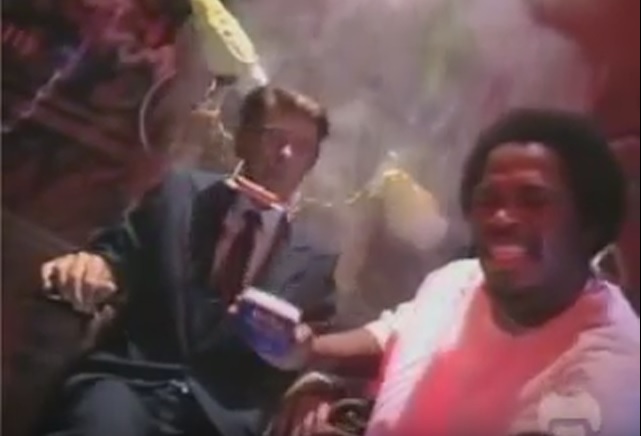
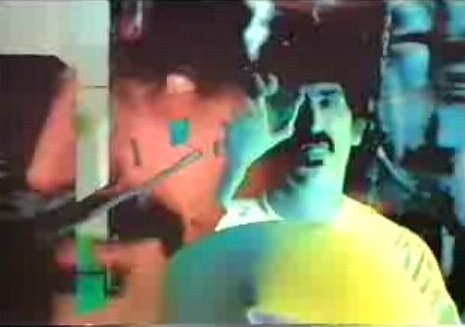
Two stills from the You are what you is clip, the video that MTV refused to air, but this channel compensated Zappa by broadcasting one of his concerts.
To the left: Ike Willis with Reagan-look alike.
13. Mudd club (1980) - City of tiny lites (1980)
"Mudd club" has one theme, sung at the beginning and the end. In between you've got Zappa talking over a vamp with an electronically
modified voice, using the same accompanying pattern as the theme. Tracks 13-15 from "You are what you is" would return in an adapted form on the 1984 album "Thing-Fish".
The main theme from "Mudd club (1984)" is included in the corresponding section, as well
as some background information about this former New York club.
In 2023 the ZFT released "Zappa '80 Mudd Club/Munich" with a live version of "Mudd Club" from both venues. In the liner notes Arthur Barrow writes that the vamp is reggae.
This comes out quite sharply when listening to the opening from the Mudd Club concert.
Mudd club (1980), 0:00-0:11 (midi file).
Mudd club (1980), 0:00-0:11 (transcription).
The example from above contains the first four bars of the "Mudd Club" version actually recorded at the Mudd Club itself, with Zappa beginning with talking to audience.
Zappa liked what he saw there and arranged that he could give a concert at this club. A one time only type of concert during this period for a smaller audience, recorded
on a two-track recorder positioned behind the bar.
The downbeat is very weak, for which reason I included the drum part, notated without much details. In bar 1 it's a bass drum beat at the downbeat.
The bass pauses on the downbeat during all four bars of this example. Something similar is going on during "Panty rap".
More characteristic of reggae are the rhythm guitar chords between beats, or on beats two and four, depending on the tempo and how you're notating it.
City of tiny lites (1980), 1:57-2:11 (midi file).
City of tiny lites (1980), 2:45-3:06 (midi file).
City of tiny lites (1980), sections (transcription).
The "Mudd Club" CD also contains an example of how the band performed the "City of tiny lites" solo during the last tours before it got replaced by the Carlos Santana vamp,
that you can hear on "Shut up 'n play yer guitar" (see the corresponding section). It's a two-bar vamp with the progression Fsus4-Gadd4-C-Bb.
The G gets sustained by far the longest, thus becoming the tonic. It doesn't follow one particular scale, but vacilates while the solo is progressing.
During the opening bars (first example) the G-chord with its B natural sets the scale to Mixolydian. When the soloing starts the Fsus4 and Gadd4 chords
get replaced by ad lib. harmonies in the background. Zappa soon starts to play a Bb and sometimes also an Eb (second example). So it gets to sound as Dorian
and sometimes Aeolian. As noted repeatedly in this study the mingling of closely related scales is common in Zappa's output.
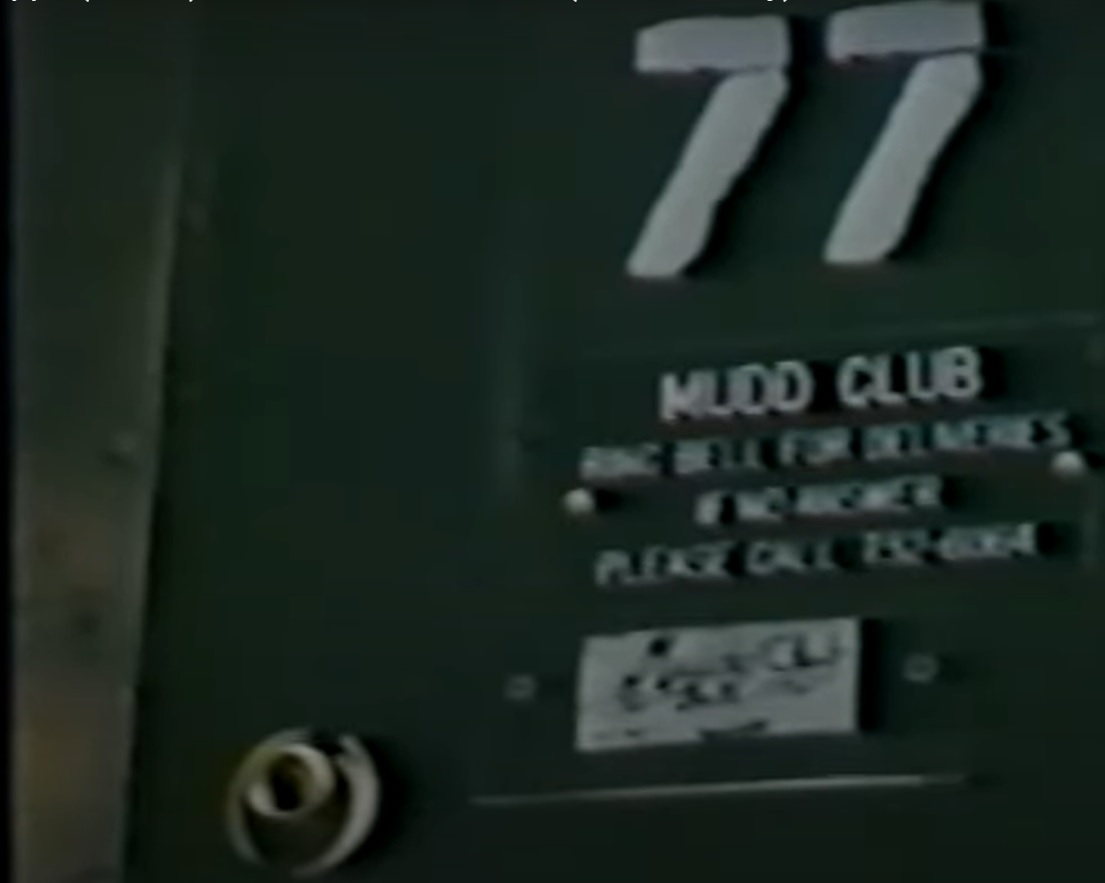
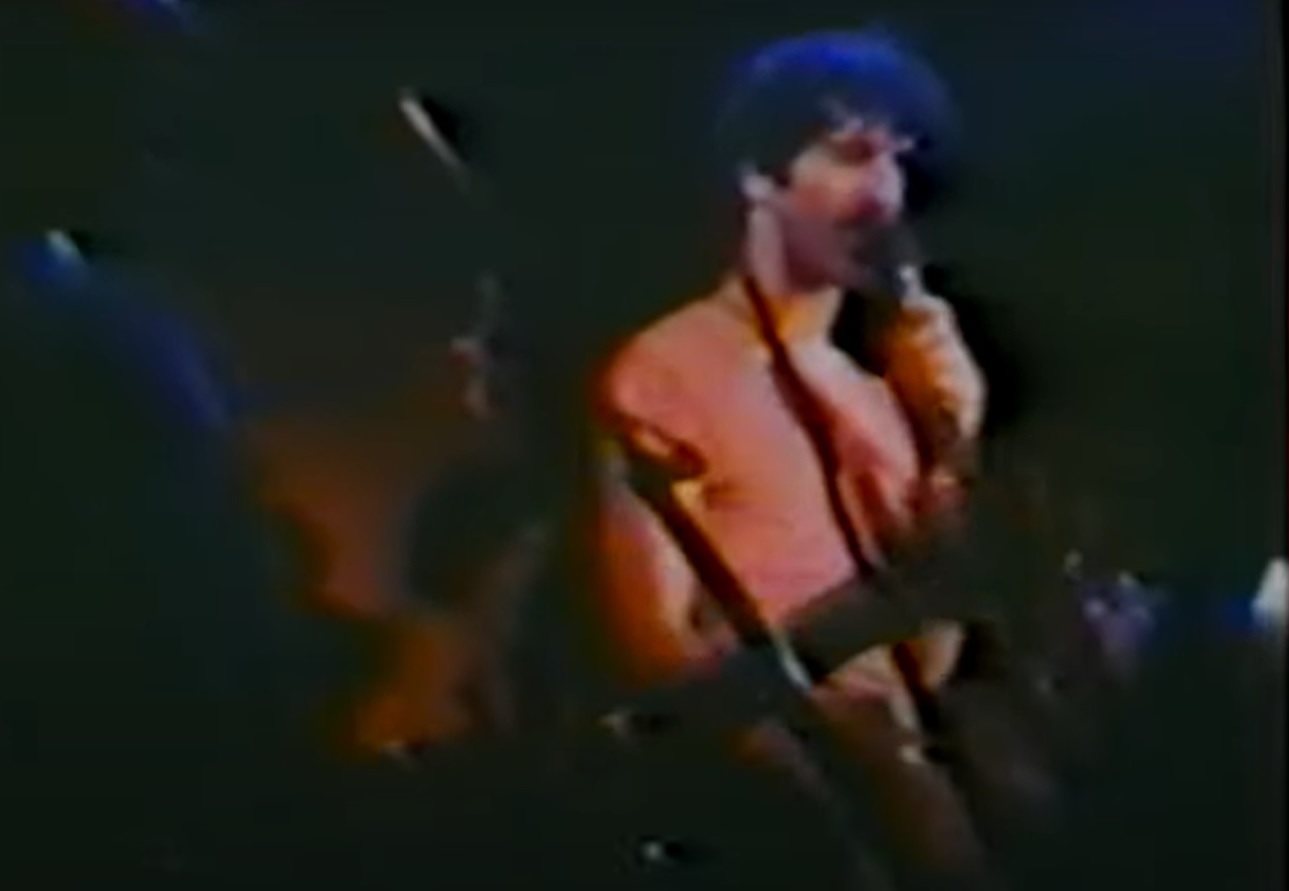
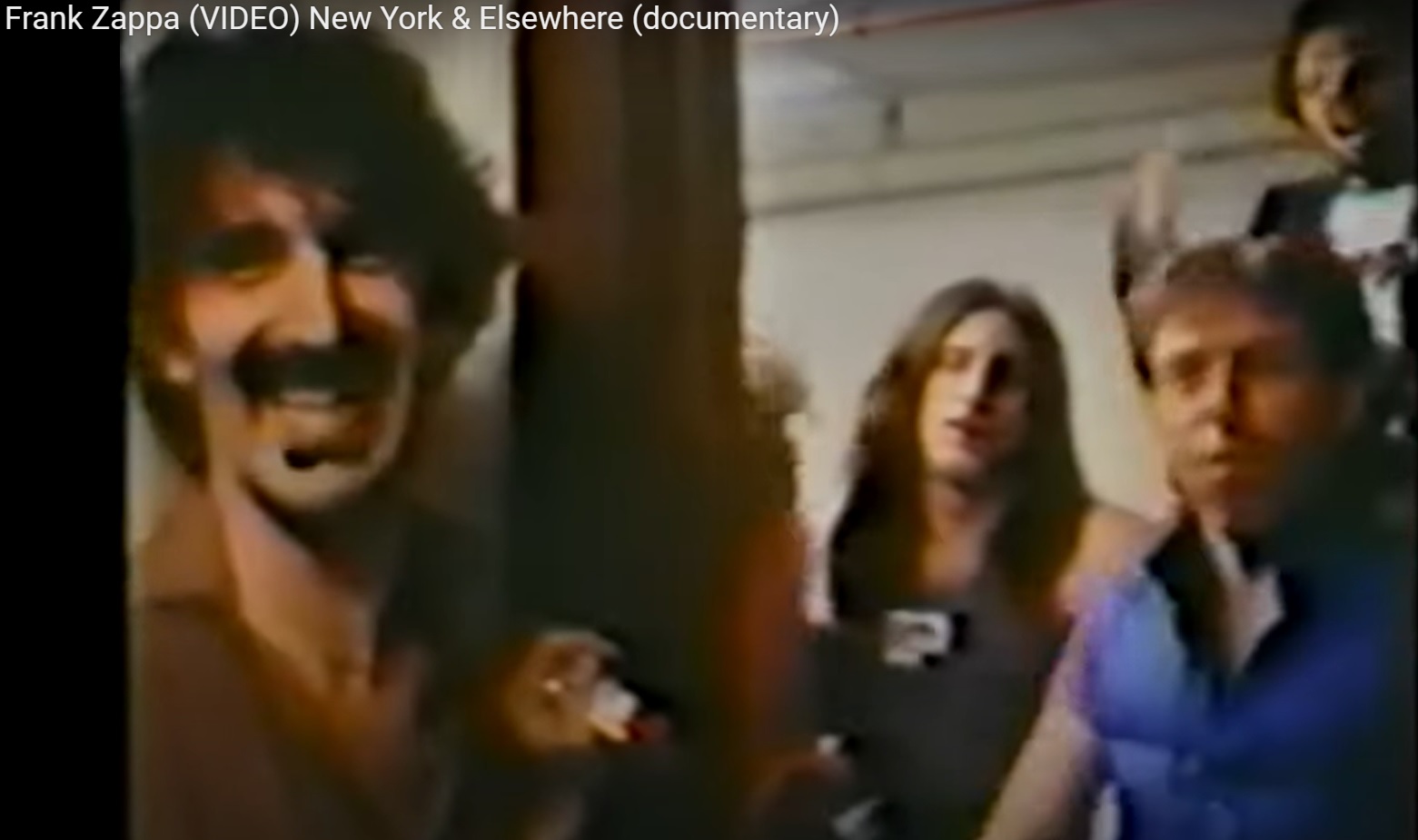
Zappa at the Mudd Club. Three stills from the Frank Zappa: New York and Elsewhere documentary by Rudi Dolezal and Hannes Rossacher.
Mainstream pop music
14. The meek shall inherit nothing
"The meek shall inherit nothing" is accessible mainstream pop. This doesn't go for the lyrics. Together with "Dumb all over" and
"Heavenly bank account", they form an effective criticism upon the negative side of religion. Especially "Dumb all over" is very well written, and audacious
with Zappa using blasphemy to accentuate his argument.
The meek shall inherit nothing, 1:33-1:56 (midi file).
The meek shall inherit nothing, 1:33-1:56 (transcription).
The outlines of "The meek shall inherit nothing" go as:
0:00 Opening - transition from the preceding "Mudd club" track to the main theme from this song.
0:13 Main theme.
1:02 Second theme with Zappa speech-wise singing with electronically modified tones.
1:21 Third theme.
1:43 Main theme again.
2:07 Main theme in another rhythm.
2:32 Main theme in its first shape some more.
2:56 Outro - transition to "Dumb all over".
3:10 End.
The example from above begins with the last three bars from theme three. It's an up going line from Ab to Db by the bass, with
the other parts moving in a contrary direction. It ends with an instrumental bar in Db Mixolydian.
The next four bars are the core of the main theme. They follow a chord progression, being Gb-Fb-Ebm-Gb. It's using Gb major
and Gb Mixolydian next to each other. It's performed in a rather loose manner with a lot of improvisation to it. Three guitars and two keyboards
are filling in the harmony. As usual in Zappa's arrangements, the vocalists don't sing identical notes, but are forming harmonies instead.
The bass is playing around pedal notes in a free manner.
Rock and roll (cntd.)
15. Dumb all over
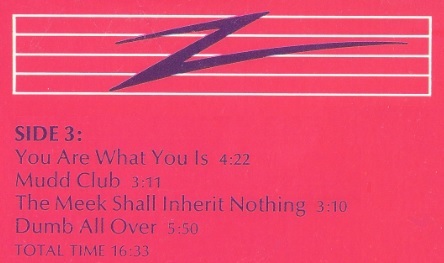 The inclusion of tracks 14 through 16 got partly triggered
by the popularity of some TV evangelists, that particularly irritated Zappa. "Dumb all over" is a rock piece with a rap sermon
against religion in general. Like in "Mudd club", he has his voice also being electronically modified as described below. Live this couldn't be done and a second theme got added to compensate for this.
These live versions can be found on "YCDTOSA Vol. II" and "Have I offended someone?". The song ends with the chorus
repeating the last sentence from the sermon as a vamp, over which Zappa is playing a solo. In Greg Russo's Cosmic Debris book
it is said that Zappa edited out this solo on the CD issues. My CD is the one by Rykodisc with number RCD 10536. Indeed this track gets
listed as lasting 4:03 minutes, which would mean the solo got skipped ... on some releases? When I'm playing it I'm actually
getting this song with the full length of the original album, lasting 5:50 minutes (image to the left). Luckily so, because it's a strong solo.
The inclusion of tracks 14 through 16 got partly triggered
by the popularity of some TV evangelists, that particularly irritated Zappa. "Dumb all over" is a rock piece with a rap sermon
against religion in general. Like in "Mudd club", he has his voice also being electronically modified as described below. Live this couldn't be done and a second theme got added to compensate for this.
These live versions can be found on "YCDTOSA Vol. II" and "Have I offended someone?". The song ends with the chorus
repeating the last sentence from the sermon as a vamp, over which Zappa is playing a solo. In Greg Russo's Cosmic Debris book
it is said that Zappa edited out this solo on the CD issues. My CD is the one by Rykodisc with number RCD 10536. Indeed this track gets
listed as lasting 4:03 minutes, which would mean the solo got skipped ... on some releases? When I'm playing it I'm actually
getting this song with the full length of the original album, lasting 5:50 minutes (image to the left). Luckily so, because it's a strong solo.
Dumb all over, 0:00-0:16 (midi file).
Dumb all over, 0:00-0:16 (transcription).
The riff of "Dumb all over" is a figure of one bar with the progression V-III-I-VI-I-II in Db Lydian. Sometimes it's just the bass, at other points the bass with guitar chords.
Stylistically you might call it rock 'n roll. Zappa sings the lyrics in the shape of a meltdown. It gets doubled by an electronically mutated second track with his voice,
that copies the exact rhythm but not the pitch. The pitch of the second line is going up and down chromatically. How this is done, I can't tell. That also goes
for the synthesizer line in bar 7, staff 3. It's a rapid wave of repeating downward major seconds, where the pitch position of this major second is going upwards. Its rhythm fluctuates a bit and
its movement also involves quartes tones, so it must have been achieved electronically. In bar 7 you can briefly hear a second voice in the background, the higher Ab and Db at "And if ...",
so it looks like Zappa might have had a second singer to sing along with him, at least at some spots.
Gospel
16. Heavenly bank account - Church chat
"Heavenly bank account" is his only full blown attempt at gospel, following all the stereotypes of this genre. It opens
with a "preacher" singing to the community with a choir and keyboard backing him up. The chord progression in rock terms is
G-G-C-C#m-5 -G-G-Em-Am-D (bars 1-16). The main part of the song starts
in bar 18 with the central theme in G Lydian. Between these two blocks you've got Zappa talking in bar 17 without a meter.
Heavenly bank account, opening (midi file).
Heavenly bank account, opening (transcription).
"Heavenly bank account" is another example of Zappa adapting the speed of a song. It lasts 4:03 minutes on the original album, compared to
the 3:44 minutes on CD. In this case
the frequencies got right between keyboard frequencies, thus creating all quartertones. When you're listening
to it normally that's no problem, but when you're transcribing it with the aid of a keyboard, that's really nasty. It's
transposed a quartertone down in the transcription.
"Church chat" was recorded during the 1982 tour, being included in "YCDTOSA Vol. IV". It's a recitative that could be called gospel regarding its style.
It sounds like keyboard harmonies that accompany a preacher trying to enthuse the attendents. The text, in case of Zappa, is of course doing the opposite.
Church chat, 0:00-0:15 (midi file).
Church chat, 0:00-0:15 (transcription).
This piece is in E with many altered notes being used. In this case the progression is
E-F#m-E-Em-5 -Gm-5 -E-A-Ab-A-B-A-B-A-B-A-E. The altered notes can be seen as passing:
- E-Em-5 -Gm-5 -E: E moving over to a dissonant Em7-5 chord (spread out over two chords), resolving back to E.
- A-Ab-A: a chromatic movement of major triads.
Blues
17. Suicide chump
"Suicide chump" is a song from "You are what you is", following the standard blues pattern. With this song the final third
sequence from "You are what you is", this time more about people living at the self-side of society.
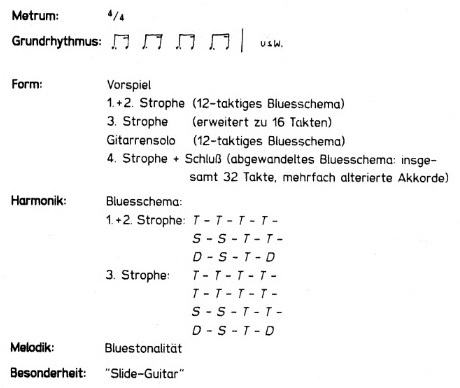
Blues scheme from Suicide chump. Source: Wolfgang Ludwig, Untersuchungen zum musikalischen Schaffen von Frank Zappa, page 231.
The German chord symbols stand for: T (tonic) = I, S (subdominant) = IV, D (dominant) = V.
Ludwig depicts the blues scheme from this song as above.
Blues examples included in this study are for instance "Grunion run"
and "Sexual harassment in the garage". See the Imaginary diseases section at "Been to Kansas City in A minor" for an overview of blues examples in
this study, as well as the Bongo fury section at "200 Years old" for some more about blues.
Suicide chump, 0:00-0:30 (midi file).
Suicide chump, 0:00-0:30 (transcription).
The example contains the opening and first cycle of the blues scheme:
- Bars 1-4: the song begins instrumentally upon step I of the blues scheme. The key is Eb Dorian and the meter 12/8, or 4/4 with triplets (see above
for the exact pitches of notes on the CD). The bass follows the blues scheme rather tight, while keyboards and guitars are improvising along it.
- Bars 5-8: the verse begins on step I. Till bar 7 the song has remained following minor pentatonic. In the harmonies from bar 8 the other two notes
from the Dorian scale first turn up.
- Bars 9-10: step IV of the scheme.
- Bars 11-12: return to step I.
- Bars 13-14: steps V and IV with just a bass note and a chord on the first beat. Otherwise Zappa sings more or less solo.
- Bars 15-16: steps I and V with the instruments playing rather loose at this point.
Suicide chump (11-01-1981), guitar solo (midi file).
Suicide chump (11-01-1981), guitar solo (transcription).
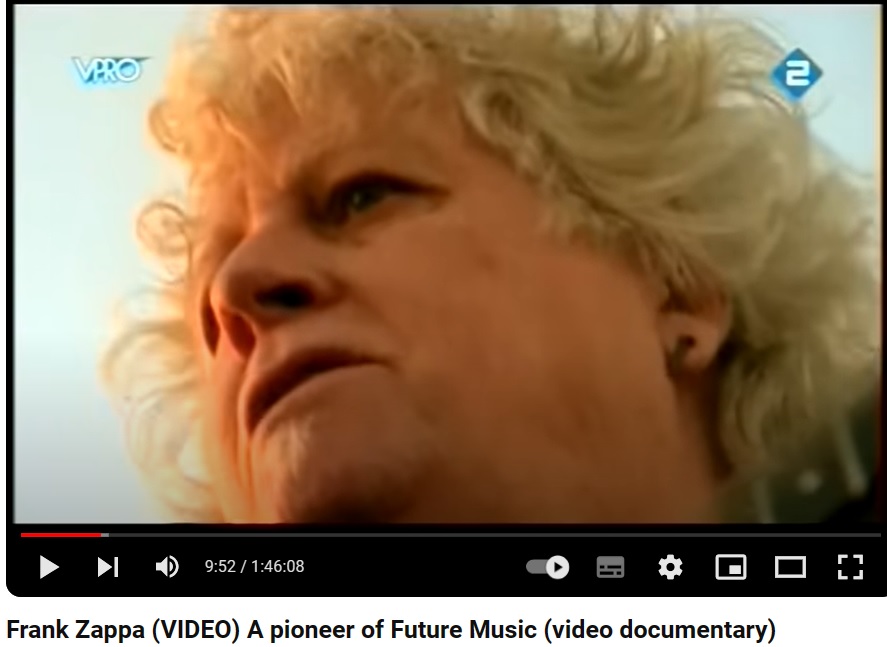 On the "You are what you is" album, Denny Walley plays a guitar solo. To the right a still from the "Zappa, a pioneer of future music" documentary
by Frank Schaeffer. Denny Walley knew Zappa since the fifties when both lived in Lancaster as teenagers. He brings up memories and can be seen playing "Suicide chump".
In 2020 the ZFT released all of the 1981 Halloween concerts, including
two live versions of "Suicide chump". Live five people played a solo, each playing two times through the blues scheme. The example above
is Zappa himself playing the first cycle on November 1st, to be heard between 3:04 and 3:25. The other execution has also been released on "YCDTOSA Vol. I" in an edited, shorter version.
It's standard blues with Zappa playing at his average best. The key is D Dorian with several notes getting altered. The harmony on step five follows an A major chord,
common practice in blues. Another common practice in Zappa's music is the mingling of Dorian and Mixolydian. The presence of an F# in the keyboard part, bar 3, staff 2,
is normal, even when it causes dissonances with Zappa's soloing.
On the "You are what you is" album, Denny Walley plays a guitar solo. To the right a still from the "Zappa, a pioneer of future music" documentary
by Frank Schaeffer. Denny Walley knew Zappa since the fifties when both lived in Lancaster as teenagers. He brings up memories and can be seen playing "Suicide chump".
In 2020 the ZFT released all of the 1981 Halloween concerts, including
two live versions of "Suicide chump". Live five people played a solo, each playing two times through the blues scheme. The example above
is Zappa himself playing the first cycle on November 1st, to be heard between 3:04 and 3:25. The other execution has also been released on "YCDTOSA Vol. I" in an edited, shorter version.
It's standard blues with Zappa playing at his average best. The key is D Dorian with several notes getting altered. The harmony on step five follows an A major chord,
common practice in blues. Another common practice in Zappa's music is the mingling of Dorian and Mixolydian. The presence of an F# in the keyboard part, bar 3, staff 2,
is normal, even when it causes dissonances with Zappa's soloing.
Mainstream pop music (cntd.)
18. Jumbo go away - Number 6
Most pop-music follows standard patterns, not specifically related to a certain style in a technical sense. It's using a rather limited number of chord types with the meter
normally being 4/4, the reason why "new" albums mostly sound as if you already know them. These standards also occur frequently in Zappa's music, but they get mingled
with a bewildering variety of non-standards. It makes the analysis of his songs interesting, even after some 500 examples. You still don't know for sure what the next
one brings. "Jumbo go away", described beneath, knows normal chord progressions next to chromatic passages and an interlude, that's far away from pop standards.
The third sequence of songs with related subjects on "You are what you is" are tracks 17-20, this time about people who fail socially. It's
part of the Zappa folklore that Moon Zappa entered her dad's business by writing him a letter about the idea of impersonating
a Valley girl (included in the "Drowning witch" CD booklet). Actually she made her debut on "You are what you is" and probably
Frank had asked her. She's the one doing the high vocals of Jumbo in the transcription below, like "feed me". "You are what you is"
uses a wide range of singers, nine in total. As done more often, Zappa doesn't use the singers here to sing identical parts, but lets them sing in parallels
and/or some devious lines. In the pick-up bar for instance you have four times a Db over the main melodic line, F-G-Ab-Bb. Next you've got staves
1 and 2 moving on via parallel thirds. In bar 11 you've a lead melody with the other singers forming two accompanying chords.
Examples of the use of vocal parts in this way are numerous. The subject already came by in the examples sung by Flo and Eddie. Other
examples in this study with creative ways of using vocal parts are for instance "Flakes" (2nd example), "I have been in you" (opening bars),
"Doreen" (example above, bar 7), "Heavenly bank account" (opening with the gospel choir) and "The mammy nuns". The construction of "Jumbo go away"
goes as follows:
- 0:00 Theme I with a I-II chord alternation in Eb Mixolydian. If you would take the G-Ab bass notes as leading
it would lead to an obscurity, G Locrian, so I think most people would rather call it Mixolydian.
- 0:16 Theme II in Bb Dorian with the guitar chord progression I-IV-I-IV-III.
- 0:27 Theme I. The transcription below starts at 0:31 with this theme.
Jumbo go away, 0:31-1:02 (midi file).
Jumbo go away, 0:31-1:02 (transcription).
- 0:41 Theme II.
- 0:50 Chromatic passage with a constantly descending melody (bars 9-10 from the transcription).
- 0:55 Theme III in G Dorian with the guitar chord progression I-IV. The transcription ends here.
- 1:13 Theme III some more, now transposed up a minor second.
- 1:30 Instrumental interlude.
- 2:20 Theme I.
- 2:35 Theme II.
- 2:47 Theme I.
- 3:01 Theme II.
- 3:10 Postlude ("wash up your pie"), making the transition to the next song as it comes to the lyrics.
- 3:43 End.
The interlude is a highly irregular section, not specifically related to the other parts of this song.
It used to be available via Barfo Swill, first as "Number 6". Later on, once it got used for this song,
as the "Jumbo go away interlude". See below for some examples.
Number 6, bars 1-4 (midi file).
Number 6, bars 1-4 (score).
Originally this interlude was written for a wind quintet. During bars 1-4 the flute, oboe and clarinet
are playing parallel, while the horn and bassoon are mostly playing sustained notes. All is obviously atonal
and rhytmically irregular. On Youtube I came accross a film by Tyler Bartram (https://www.youtube.com/watch?v=GJHIgjJFrN0),
where the structure of "Number 6" is being demonstrated. In it the whole score is coming by, which almost has to be
the original score in a reduced form.
Jumbo go away, 1:57-2:07 (midi file).
Number 6, section (midi file).
Jumbo go away, 1:57-2:07 - Number 6, section (score).
When you're comparing this score with the album, you'll notice that it is basically the same, but regarding details somewhat differently.
Such differences between scores and actual recordings are common practice in Zappa's music. I'm giving an overview in my
Uncle Meat section. On the album the score is played in different registers: the bass plays an octave lower and the descant an octave higher.
The tempo is extremely high, probably sped up.
As also happening during other tracks from "You are what you is", changing the speed has the effect that the pitches are getting out of tune
with keyboard frequencies. Most of the time it sounds closer to being transposed a minor second up, while in some bars it can also sound closer to
the pitches of the score. My guess is that this isn't happening intentionally, but as an effect of minor fluctuations.
Because of this the original score is way better fit for analysing the melody than my presentation of how it sounds on "Jumbo go away".
The speed, combined with being out of tune with keyboard frequencies, makes transcribing the interlude really nasty, so the original score came in very handy.
The following indicates some structure building elements, as also done during the film,
based upon the original score (the bar numbering is from my presentation).
- Bar 1: a figure in 6/16 that is getting varied upon during bars 2 through 13.
The score notation shows the lead melody as strings, spread out over two staves, which suggests that it involves two instruments playing in hocketing
manner. On the album this is handled differently by two or three keyboard tracks. During bars 1-4 I'm hearing a second keyboard part
playing just a G# halfway each bar.
- Bar 2: this bar is repeating bar 1 except for it's tail, the last two notes of the lead melody are different.
- Bars 3-4: the melody is repeating bars 1-2. The bass is following a line of its own, descendingly during bars 1-6.
Because of the high tempo, the bass part sounds as a counterpoint melody.
- Bars 5-8: the notes from bar 1 are getting transposed, though as subsets of notes and with the possiblity of changing the intervals. Staff two is transposed a major second down during bars 5-6, and again a minor second
down in bars 7-8. Staff one knows two sets of two notes per bar. In bar 7 you can see that the following order of the sets of two notes from the preceding bars is exactly reversed.
It's a mirror movement, a technique known from the Baroque counterpoint era, in this case applied in an atonal environment.
This has something of a mathematic approach, as if the variations are based upon applying formulas.
Also present in the film is Brett Clement, pointing at another technique, that Zappa applied more often, namely varying the rhythm of a melody while the pitches are kept the same
or transposed. I've added his example from his 2009 study below the example from above with two such examples, which Brett likes to call "isomelisms" ("same melody").
The numbers correspond with the repeating notes.
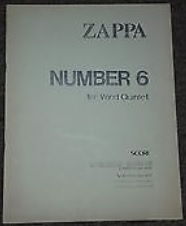
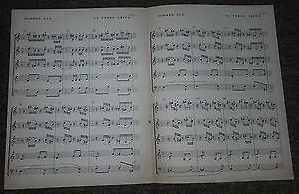
Two thumbnails of the Number 6 score.
19. If only she woulda
The central theme from "If only she woulda" is built around a keyboard chord progression: I 7th-IV-I-IV in B Dorian.
The whole song is in 4/4. An instrumental interlude takes up about half of the piece:
- 0:00 Theme one (central theme).
If only she woulda, 0:29 till 0:46 (midi file).
If only she woulda, 0:29 till 0:46 (transcription).
- 0:39 Theme two. Partially chromatic progression, unrelated to a specific key: Bm-Bbaugm5-D-F#.
- 0:45 Theme one.
- 0:59 Keyboard solo over a I-IV alternation in B Dorian. The bass continues vamping as during theme one, while the chords
are played in a somewhat different positioning.
- 1:28 Guitar solo.
- 3:00 Theme one.
- 3:30 Theme two.
- 3:37 Theme one.
- 3:48 End.
20. Drafted again - I don't wanna get drafted
This song segues into "Drafted again". This track got released earlier as a single, carrying the title "I don't want to get drafted". This single version can be
found on "The lost episodes". In the liner notes Rip Rense notes that "Keyboardist Tommy Mars reports that the tune started out with FZ obsessively repeating a guitar riff
(the same chord progression as the "I don't want to get draaaaaaaft-ed" line that is followed by bouncing drum fills): "Frank was doing it incessantly, like he did all the time
once he found a lick he really liked [...]".
The "You are what you is" version is more phrenetic, with vocal parts by Ahmet and Moon.
Drafted again, 2:07-2:20 (midi file).
Drafted again, 2:07-2:20 (transcription).
The example above is the outro, made up of three motifs, slowing down towards the end.
- Bars 1-2: first motif with one bar in 5/4 and one in 4/4.
- Bars 3-4: second motif with a repeating keyboard figure in 4/4.
- Bars 5-6: third motif with a repeating guitar figure in 4/4.
Staff one of bars 5-6 represent the background vocals and snorks you can hear all through this song. With the C and F turning up as sharp and natural, the outro doesn't follow one particular
scale. One might say bar 1 starts in D. Bars 2-4 can be identified as C Lydian. Bars 5-6 are the guitar and drums playing alone, just F and G, with the mentioned background vocals.
I don't wanna get drafted, 1:24-1:48 (midi file).
I don't wanna get drafted, 1:24-1:48 (transcription).
This second example is half of the instrumental interlude from this song, as played during "I don't want to get drafted". It contains a melody line that is getting repeated four times.
The rhythm guitar gives this interlude a reggae flavour.
It doesn't have specific tonic or follow a specific key, the bass and chords are chromatically moving downwards. It starts as if in D and ends as a harmonic cadence in Bb Lydian. During the third and fourth time
this melody is played, the piano is playing the chords in an arpeggiated manner, as commemorated in the liner notes of the "The lost episodes" booklet. At the end of this example
two bars are included with Tommy Mars doing this. How the meters should best be notated during this example is not that clear neither.
Below some more styles get mentioned, that you can encounter in Zappa's music. References are made to examples from other sections from this study.
Jazz
Jazz gets amply dealt with in the Waka/Jawaka, The grand wazoo and Imaginary diseases sections, next to jazz-rock in the Hot rats section.
Lounge music
Lounge music can be seen as a form of easy-listening jazz, combined with pop-standards. "America drinks" from "Absolutely free"
is included in this study. The "Chunga basement" version of "Chunga's revenge" is dealt with in this study as well. One might call
this more relaxed version lounge music too.
Atonal music
This is more a category of music than a style. The many examples of atonal music in this study are listed in the Burnt weeny sandwich section.
Serial music
This might to a point be called a style within atonal music. Apart from a juvenile attempt (see the Zappa's teens section), it had no influence upon Zappa's music.
Doo-wop
The Ruben and the Jets section deals with Zappa's tribute to this style, popular in the fifties.
Waltzes
Examples of waltzes coming by in this study are "Sofa" and "Strictly genteel". The "Waltz for guitar" and the "Waltz" from the Cucamonga archive are called
that way for their 3/4 meter, but for the remainder these two songs are stylistically untypical of waltzes.
Tangos and ballroom music
Zappa wrote two tangos during his lifetime. The Roxy and elsewhere section includes a subsection dedicated to his tangos. "Paroxysmal
splendor" contains a section with ballroom music (see the Heidelberg section). "The tuna sandwich bolero" is a bolero with some liberty.
Disco
The occurrence of disco in Zappa's music remained limited to some influences that you could call disco-like. See the Sheik Yerbouti section.
Rap
With "Trouble every day" Zappa wrote a song in 1965 that during the eighties retrospectively could be called rap. "Promiscuous" from "Broadway the
hard way" is his only genuine rap song. See the corresponding section. It's the last time Zappa would react to a trendy style.
Ballads
Slow sentimental pop songs sometimes get referred to as ballads. "Lucille has messed my mind up" is an example from the Zappa catalogue. Rhythmically this
song is also reggae, played very slowly.
World music
A term to cover non-Western styles of music. Some examples are present in Zappa's output. I'm dealing with this subject in the Documentaries section.
Folk music
Only marginally present. The subject is coming by in the Finer moments section at "You never know who your friends are"/"Harmonica fun".
"Call any vegetable" contains a few bars with yodeling, present in the Absolutely free section.
Minimal music
Minimal music came up in the sixties, the idea being letting limited thematic material getting varied upon with only minor changes.
The purpose is to create a meditative atmosphere, while some just find it boring. One might argue if not Erik Satie should be seen as a predecessor. It looks like
Zappa wasn't interested in composing like that, but he did take a minimalistic approach to music in cases he wanted to let the lyrics or spoken text stand central.
This subject is coming by in the Fillmore East and Thing-Fish sections, where you can find examples of vamps that are subservient to the text. "Dave & Al" from above
is another example. In the YCDTOSA vol. V section you can find a small excerpt from a 1969 experimental track, that Zappa called "Proto-minimalism" when he released
it on an official CD in 1992. Probably titled like this with hindsight. It does indeed have minimalistic elements.
Collages
Like atonal music, this is more a category of music than a style.
The subject is coming by in the Civilization phaze III and Dance me this sections.
Musique concrète
Present on a larger scale on "Civilization phaze III" as well as "Dance me this" with "Wolf harbor".
See "Waffenspiel" for a piece composed in this manner all through.
